Most of the people who know me would agree that I’m pretty much a homebody. Sure, from time to time you’ll catch me on a nature walk at Yamato Scrub, or leading a field trip for the local Audubon Society. And as a birder, I’m not immune to the temptation to drive all over creation chasing a rarity. And I’m even occasionally to be found in India. But for various reasons (new paternal duties, the price of gas, the desire to avoid damaging the environment, even just plain old personality), I prefer to stay at home and try to bring the birds to me. With this in mind, a couple of years ago we removed most of our typical south Florida home vegetation and replaced it with mostly native plants designed to attract birds and butterflies. Our yard list is small but growing, and staying around the house allows me to observe more of the many nonavian orders of life than I would if I were constantly on the move searching for birds.
For example, this morning as my clippers were poised to trim back a bit of the Coral Bean (Erythrina herbacea) from the side of the house, my attention was captured by a new lizard species. Well, it’s not new to science, or even to me, but it is the first time I’ve noticed it in our backyard. We’ve got our share of other non-native herpetofauna: the abundant Brown Anole (Anolis sagrei) and the even more abundant Northern Curlytail (Leicocephalus carinatus). In fact, there’s a curlytail living in our garage that we’re practically on a first-name basis with. He’s a giant! And he’s so used to us that he’ll barely even move as we tromp toward him on our way to the refrigerator or the laundry.
Today, however, marks the first time I’ve found the largest non-native anole in south Florida in our backyard.
I’m talking, of course, about the Cuban Knight Anole (Anolis equestris). This little lizard can get pretty big, although the one I saw today was just a juvenile:
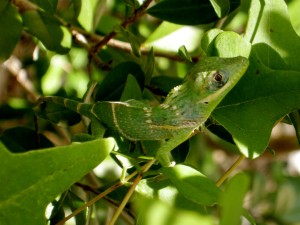
According to my Handbook to the Reptiles and Amphibians of Florida, this can be identified as A. equestris by the yellowish-white stripe under the eye and the larger stripe originating on the front and running down the side above the front leg. It can be identified as juvenile because in addition to the two aforementioned stipes, there are “white bands across the back and down onto the sides.” This non-native species, if we can believe Ray Ashton Jr (and I do–he wrote the book!), feeds on invertebrates and some vertebrates “such as small tree frogs and small lizards.” These guys are also supposed to be highly arboreal, running to the very tops of trees when alarmed, although this little feller didn’t do anything of the sort. At the approach of the camera, he sort of shied around the branch to stay on the opposite side from that scary lens. After I was impolite enough to insist, he skittered away from that photogenic pose I was trying to capture, and wound up where you see him now.
If you look closely at the photo, you may be able to recognize the odd triangular leaves of the Coral Bean. No other plant in Florida has leaves like it, so it’s pretty easy to recognize. It also has gorgeous red tubular flowers. A good toehold in the flora of Florida (according to my Guide to the Vascular Plants of Florida — thanks, Pop and Jan!), it can be found “nearly throughout” the state:
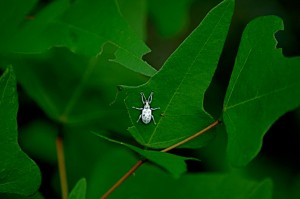
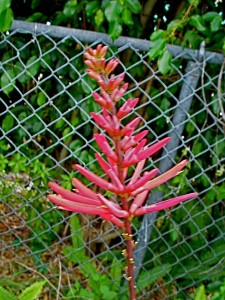
Unfortunately, because this plant is so distinctive, Wunderlin and Hansen don’t even bother to describe it, let alone key it out, so a technical description is left to others. Gil Nelson, who has written three excellent guides to Florida’s native plants, describes it in yet another book as “spiny, irregular, somtimes viney, herbaceous to woody, multistemmed shrub in northern Florida, sometimes reaching the dimensions of a small tree in southern Florida.” And he’s right. At Gumbo Limbo Nature Center, I’ve seen a coral bean over 20 feet tall. Gil characterizes the leaves of E. herbacea as “attractively divided into 3 triangular leaflets with pointed tips”; it is one of the few almost unmistakeable plants in the landscape.
One note of caution: like many brightly colored objects in nature, the red seeds are poisonous. This color scheme is an example of aposematic coloration; the same type of color scheme used by Monarch butterflies and their several mimics. They feed on milkweed plants, which imparts poisonous qualities to their body tissues. Any bird who eats a Monarch will never eat another one, although it will probably survive the encounter.
Speaking of butterflies, until today, I had never seen a dead one in nature. But that changed this afternoon, while I was mowing the lawn. I ran across (not over) this sulfur butterfly which had obviously seen better days. Its wings were almost entirely deflated, its flying days over:
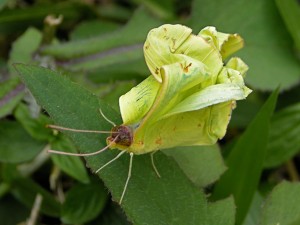
We get scores of these butterflies in our yard, attracted to our Desert Senna (Senna polyphylla). This is one of several non-native plants in our landscape. It’s not an invasive plant, and it attracts very pretty butterflies, and has gorgeous yellow flowers almost year-round, so in spite of the fact that it’s not “site-appropriate,” we’re happy to have this mexican member of the cassia family in our yard. Although I didn’t collect the butterfly (where would I keep it?), I’m fairly confident that it was an orange-barred sulfur like the one below. I see them all the time at Fern Forest, and at home. This is what the butterfly above might have looked like in its heyday:
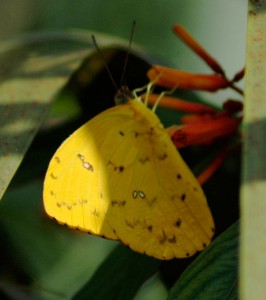
So there we have it. A routine day of yard work brings me into contact with representatives from the phylum Chordata, the order Lepidoptera, and the kingdom Plantae. And I didn’t even mention the Loggerhead Shrike that was watching me for part of the day!
